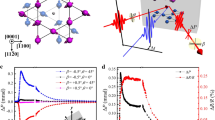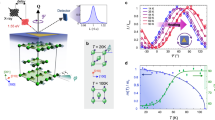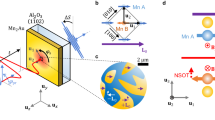Abstract
All magnetically ordered materials can be divided into two primary classes: ferromagnets1,2 and antiferromagnets3. Since ancient times, ferromagnetic materials have found vast application areas4, from the compass to computer storage and more recently to magnetic random access memory and spintronics5. In contrast, antiferromagnetic (AFM) materials, though representing the overwhelming majority of magnetically ordered materials, for a long time were of academic interest only. The fundamental difference between the two types of magnetic materials manifests itself in their reaction to an external magnetic field—in an antiferromagnet, the exchange interaction leads to zero net magnetization. The related absence of a net angular momentum should result in orders of magnitude faster AFM spin dynamics6,7. Here we show that, using a short laser pulse, the spins of the antiferromagnet TmFeO3 can indeed be manipulated on a timescale of a few picoseconds, in contrast to the hundreds of picoseconds in a ferromagnet8,9,10,11,12. Because the ultrafast dynamics of spins in antiferromagnets is a key issue for exchange-biased devices13, this finding can expand the now limited set of applications for AFM materials.
This is a preview of subscription content, access via your institution
Access options
Subscribe to this journal
Receive 51 print issues and online access
$199.00 per year
only $3.90 per issue
Buy this article
- Purchase on Springer Link
- Instant access to full article PDF
Prices may be subject to local taxes which are calculated during checkout




Similar content being viewed by others
References
Weiss, P. L'hypothèse du champ moléculaire et la propriété ferromagnétique. (The hypothesis of the molecular field and the property of ferromagnetism.). J. Phys. Rad. 6, 661–669 (1907)
Stoner, E. C. Magnetism and Matter (Methuen, London, 1934)
Néel, L. Propriétés magnétiques de l'état métallique et énergie d'interaction entre atomes magnétiques. Ann. Phys. IIe Ser. 5, 232–237 (1936)
Jubileum issue. J. Magn. Magn. Mater. 200, 1–789 (1999).
Roukes, M. L. Electronics in a spin. Nature 411, 747–748 (2001)
Landau, L. D. & Lifshitz, E. M. Electrodynamics of Continuous Media (Pergamon, Oxford, 1960)
Vonsovskii, S. V. Magnetism (John Wiley & Sons, New York, 1974)
Gerrits, Th., van den Berg, H. A. M., Hohlfeld, J., Bär, L. & Rasing, Th. Ultrafast precessional magnetization reversal by picosecond magnetic field pulse shaping. Nature 418, 509–512 (2002)
Schumacher, H. W. et al. Phase coherent precessional magnetization reversal in microscopic spin valve elements. Phys. Rev. Lett. 90, 017201 (2003)
Schumacher, H. W., Chappert, C., Sousa, R. C., Freitas, P. P. & Miltat, J. Quasiballistic magnetization reversal. Phys. Rev. Lett. 90, 017204 (2003)
van Kampen, M. et al. All-optical probe of coherent spin waves. Phys. Rev. Lett. 88, 227201 (2002)
Ju, G. et al. Ultrafast time resolved photoinduced magnetization rotation in a ferromagnetic/antiferromagnetic exchange coupled system. Phys. Rev. Lett. 82, 3705–3708 (1999)
Skumryev, V. et al. Beating the superparamagnetic limit with exchange bias. Nature 423, 850–853 (2003)
Kittel, C. Theory of antiferromagnetic resonance. Phys. Rev. 82, 565 (1951)
Ney, O., Trzeciecki, M. & Hübner, W. Femtosecond dynamics of spin-dependent SHG response from NiO(001). Appl. Phys. B 74, 741–744 (2002)
Ferré, J. & Gehring, G. A. Linear optical birefringence of magnetic crystals. Rep. Prog. Phys. 47, 513–611 (1984)
White, R. L. Review of recent work on the magnetic and spectroscopic properties of the rare-earth orthoferrites. J. Appl. Phys. 40, 1061–1069 (1969)
Burzo, E. (ed.) Numerical Data and Functional Relationships Landolt-Börnstein New Series, Group III, Vol. 27f, 200–273 (Springer, Berlin, 1996)
Horner, H. & Varma, C. M. Nature of spin-reorientation transitions. Phys. Rev. Lett. 20, 845–846 (1968)
Shapiro, S. M., Axe, J. D. & Remeika, J. P. Neutron-scattering studies of spin waves in rare-earth orthoferrites. Phys. Rev. B 10, 2014–2021 (1974)
Koster, G. F., Dimmock, J. O., Wheeler, R. G. & Statz, H. Properties of the Thirty-Two Point Groups (MIT Press, Cambridge, Massachusetts, 1963)
Belov, K. P., Volkov, R. A., Goranskii, B. P., Kadomtseva, A. M. & Uskov, V. V. Nature of the transitions during the spontaneous reorientation of spins in rare-earth orthoferrites. Fiz. Tverd. Tela 11, 1148–1151 (1969); Sov. Phys. Solid State 11, 935–938 (1969)
Kimel, A. V., Pisarev, R. V., Bentivegna, F. & Rasing, Th. Time-resolved nonlinear optical spectroscopy of Mn3+ ions in rare-earth hexagonal manganites RMnO3 (R = Sc, Y, Er). Phys. Rev. B 64, 201103 (2001)
Landau, L. D. & Lifshitz, E. M. On the theory of the dispersion of magnetic permeability in ferromagnetic bodies. Phys. Zeit. Sowjetunion 8, 153–169 (1935)
Andreev, A. F. & Marchenko, V. I. Symmetry and the macroscopic dynamics of magnetic materials. Usp. Fiz. Nauk. 130, 39–63 (1980); Sov. Phys. Usp. 23, 21–34 (1980)
Kimel, A. V., Pisarev, R. V., Hohlfeld, J. & Rasing, T. H. Ultrafast quenching of the antiferromagnetic order in FeBO3: Direct optical probing of the phonon-magnon coupling. Phys. Rev. Lett. 89, 287401 (2002)
Yosida, K. Theory of Magnetism 125–143 (Springer, Berlin, 1998)
Acknowledgements
This work was partially supported by the European IST network SPINOSA, the RTN network DYNAMICS, the Russian Foundation for Basic Research and Stichting voor Fundamenteel Onderzoek der Materie (FOM).
Author information
Authors and Affiliations
Corresponding author
Ethics declarations
Competing interests
The authors declare that they have no competing financial interests.
Rights and permissions
About this article
Cite this article
Kimel, A., Kirilyuk, A., Tsvetkov, A. et al. Laser-induced ultrafast spin reorientation in the antiferromagnet TmFeO3. Nature 429, 850–853 (2004). https://doi.org/10.1038/nature02659
Received:
Accepted:
Issue Date:
DOI: https://doi.org/10.1038/nature02659
This article is cited by
-
Attosecond magnetization dynamics in non-magnetic materials driven by intense femtosecond lasers
npj Computational Materials (2023)
-
Emission of coherent THz magnons in an antiferromagnetic insulator triggered by ultrafast spin–phonon interactions
Nature Communications (2023)
-
Generation of third-harmonic spin oscillation from strong spin precession induced by terahertz magnetic near fields
Nature Communications (2023)
-
Synthesis and characterization of (Ce-Er)FeO3 nanocomposites for structural, optical, thermal, dielectric, electrical and magnetic applications
Applied Physics A (2023)
-
Impact of Gd+3 on structural, electrical and magnetic properties of Er1−xGdxFeO3 orthoferrites
Journal of Materials Science: Materials in Electronics (2023)
Comments
By submitting a comment you agree to abide by our Terms and Community Guidelines. If you find something abusive or that does not comply with our terms or guidelines please flag it as inappropriate.



